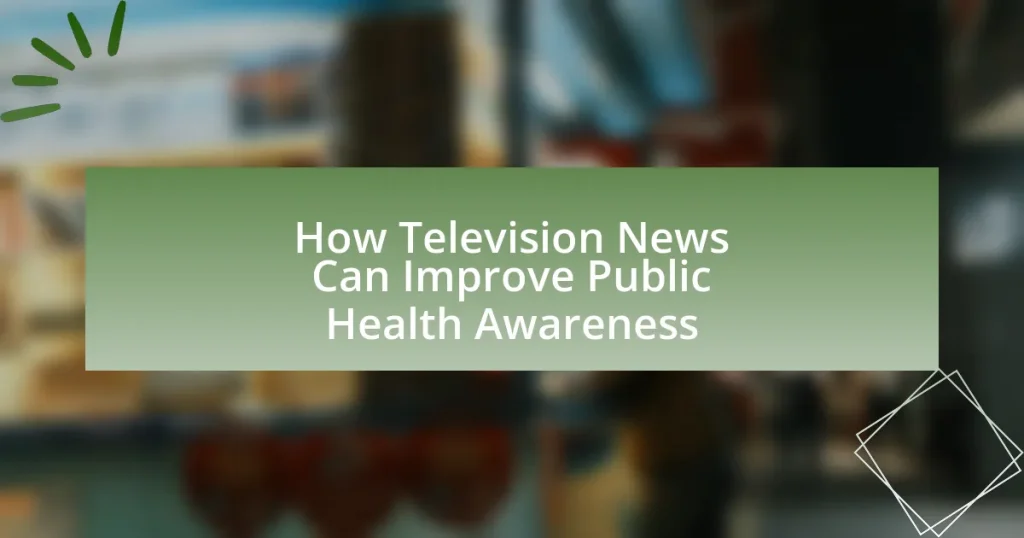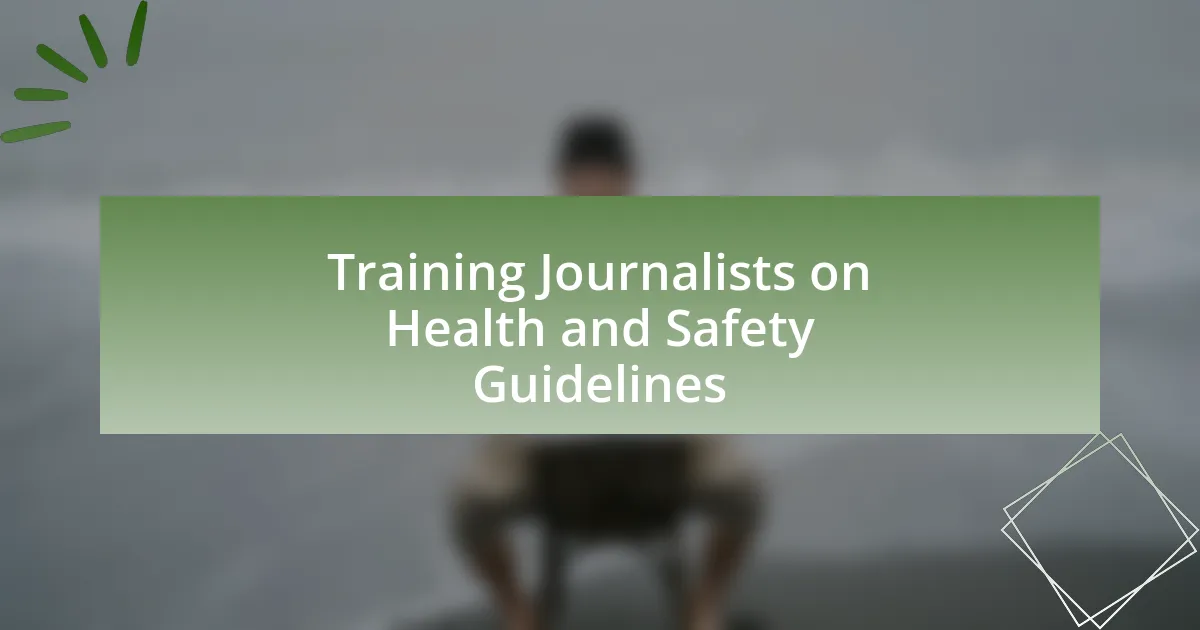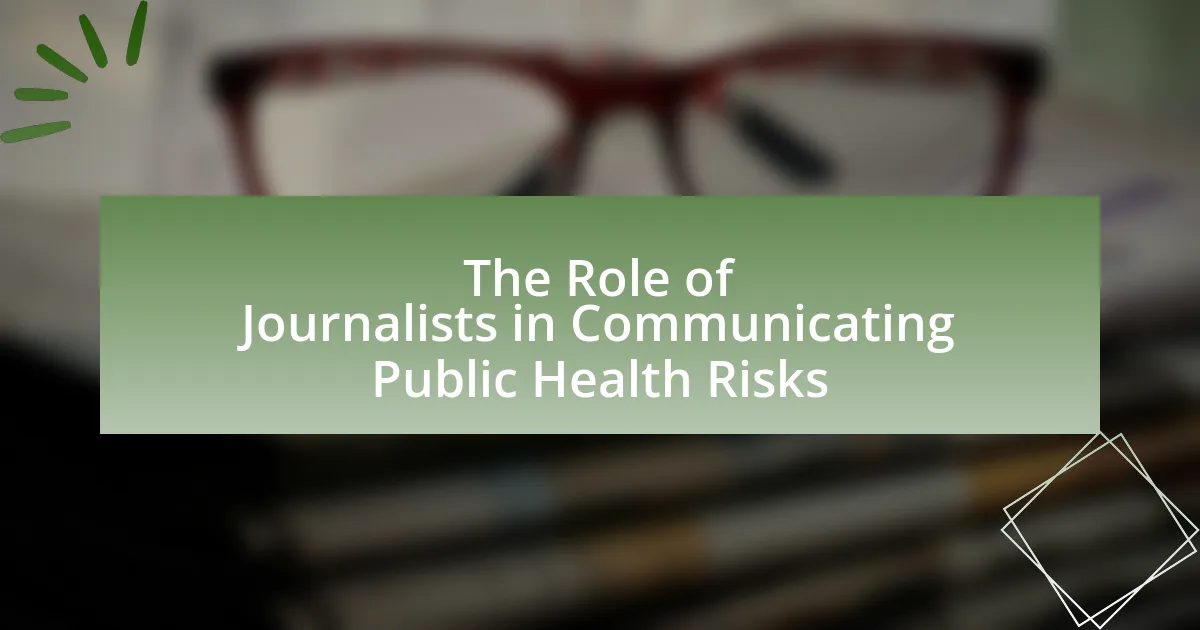Television news serves as a powerful medium for enhancing public health awareness by effectively disseminating critical health information to a broad audience. The article explores how television news influences public perceptions of health issues, the impact of story framing on audience understanding, and the psychological effects of health news on viewers. It also addresses the challenges faced by television news in promoting public health, including sensationalism and misinformation, while highlighting best practices for journalists and the importance of collaboration with health experts. Additionally, the article discusses the role of community engagement and technology in improving health communication and the outcomes of effective public health messaging through television.
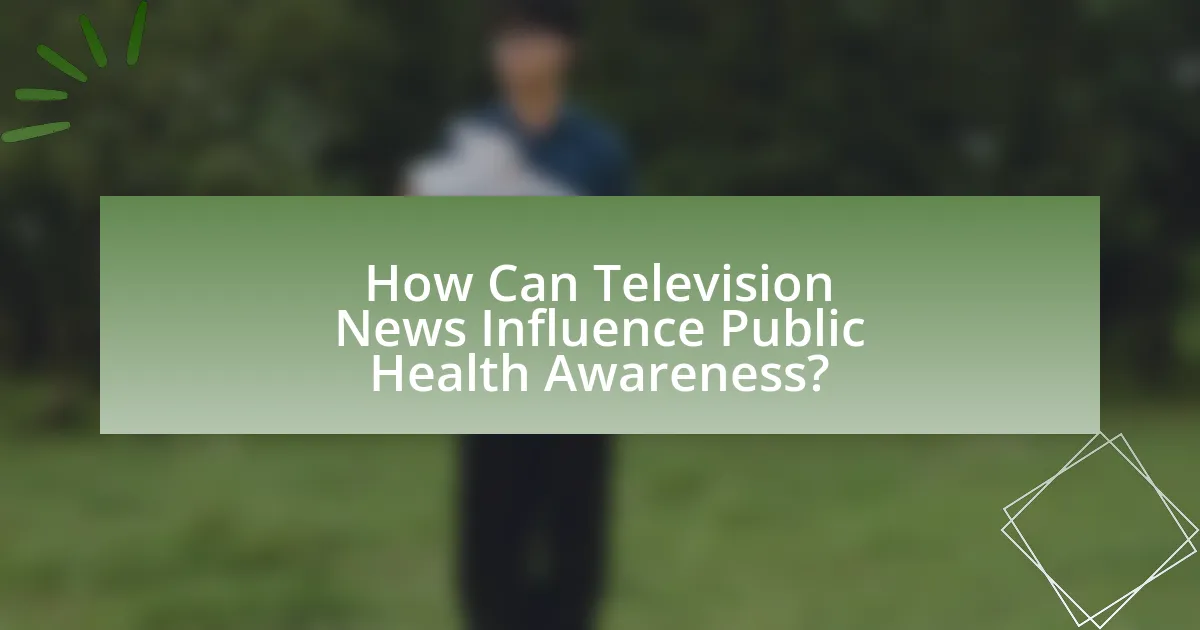
How Can Television News Influence Public Health Awareness?
Television news can significantly influence public health awareness by disseminating critical health information to a wide audience. This medium reaches millions of viewers, making it an effective platform for educating the public about health issues, preventive measures, and available resources. For instance, during the COVID-19 pandemic, television news played a crucial role in informing the public about safety protocols, vaccination availability, and the importance of social distancing, which contributed to increased compliance with health guidelines. Studies have shown that exposure to health-related news can lead to improved health literacy and behavioral changes among viewers, thereby enhancing overall public health outcomes.
What role does television news play in shaping public perceptions of health issues?
Television news plays a significant role in shaping public perceptions of health issues by providing information that influences audience understanding and behavior. Research indicates that news coverage can affect public awareness, attitudes, and even health-related behaviors, as seen during health crises like the COVID-19 pandemic, where extensive media coverage led to increased public knowledge about the virus and preventive measures. A study published in the Journal of Health Communication found that exposure to health news correlates with higher levels of health literacy and engagement in health-promoting behaviors. Thus, television news serves as a critical medium for disseminating health information and shaping societal perceptions.
How does the framing of health stories affect audience understanding?
The framing of health stories significantly influences audience understanding by shaping perceptions and interpretations of health information. When health stories are framed positively, emphasizing benefits and solutions, audiences are more likely to engage with the content and adopt healthier behaviors. Conversely, negative framing, which highlights risks and dangers, can lead to fear and avoidance, ultimately reducing the likelihood of behavioral change. Research by Entman (1993) indicates that framing affects how information is processed and understood, demonstrating that the way health issues are presented can alter public perception and response. For example, a study published in the Journal of Health Communication found that stories framed around personal success in overcoming health challenges led to increased motivation among viewers to seek preventive care. Thus, effective framing in health journalism is crucial for enhancing public health awareness and promoting positive health outcomes.
What are the psychological impacts of health news on viewers?
Health news significantly impacts viewers psychologically by influencing their perceptions, emotions, and behaviors regarding health issues. Research indicates that exposure to health news can lead to increased anxiety and fear, particularly when the news covers serious health threats, such as pandemics or disease outbreaks. For instance, a study published in the journal “Health Communication” found that individuals who frequently consume health-related news report higher levels of health anxiety, which can lead to maladaptive behaviors like excessive health monitoring or avoidance of medical care. Additionally, health news can also promote positive behaviors, such as increased health literacy and proactive health management, by providing viewers with essential information and encouraging preventive measures. Thus, the psychological impacts of health news are multifaceted, affecting both emotional responses and health-related actions among viewers.
Why is television a powerful medium for public health messaging?
Television is a powerful medium for public health messaging because it combines visual and auditory elements to effectively engage and inform a broad audience. This dual sensory approach enhances message retention and understanding, making complex health information more accessible. Research indicates that television can reach over 90% of households, providing a platform for widespread dissemination of health messages. For instance, campaigns like the CDC’s “Tips From Former Smokers” utilized television ads to significantly increase awareness and motivate behavior change regarding smoking cessation, demonstrating the medium’s effectiveness in influencing public health outcomes.
What demographic factors make television news effective for health communication?
Television news is effective for health communication due to demographic factors such as age, education level, and socioeconomic status. Younger audiences, particularly those aged 18-34, are more likely to engage with health content presented in a visually appealing and fast-paced format typical of television news. Additionally, individuals with higher education levels tend to seek out and understand health information more effectively, making them more receptive to televised health messages. Socioeconomic status also plays a role, as those with lower income may rely on television as a primary source of information, thus increasing the impact of health communication through this medium. Studies indicate that tailored health messages that consider these demographic factors can significantly enhance viewer comprehension and behavior change, ultimately improving public health outcomes.
How does the visual nature of television enhance health information delivery?
The visual nature of television enhances health information delivery by providing engaging and easily digestible content that captures viewers’ attention. Visual elements such as graphics, animations, and demonstrations can simplify complex health concepts, making them more accessible to a broader audience. For instance, studies show that people retain information better when it is presented visually; research indicates that visuals can increase retention rates by up to 65% compared to text alone. This effectiveness is crucial in public health messaging, where clear communication can influence behaviors and promote healthier choices.
What challenges does television news face in promoting public health awareness?
Television news faces significant challenges in promoting public health awareness, primarily due to limited airtime and the need for engaging content. The brevity of news segments often restricts in-depth coverage of complex health issues, leading to oversimplification or omission of critical information. Additionally, the competition for viewer attention drives news outlets to prioritize sensational stories over substantive public health topics, which can dilute the impact of health messaging. Research indicates that only 10% of health-related news stories provide actionable information, highlighting the struggle to effectively communicate essential health guidance to the public.
How do sensationalism and misinformation impact health reporting?
Sensationalism and misinformation significantly distort health reporting by prioritizing attention-grabbing narratives over factual accuracy. This distortion can lead to public panic, misinformed health decisions, and erosion of trust in credible health sources. For instance, a study published in the journal “Health Communication” found that sensationalized health news often exaggerates risks, which can result in increased anxiety among the public and a misunderstanding of health guidelines. Furthermore, misinformation can spread rapidly through social media, complicating public health responses, as seen during the COVID-19 pandemic when false claims about treatments proliferated, undermining effective health communication strategies.
What are the limitations of television news in addressing complex health topics?
Television news has significant limitations in addressing complex health topics, primarily due to time constraints and oversimplification. News segments often allocate only a few minutes to health stories, which restricts the depth of information that can be conveyed. This brevity leads to the oversimplification of intricate health issues, making it difficult for viewers to grasp the nuances and complexities involved. For instance, a study published in the Journal of Health Communication found that health news often prioritizes sensationalism over accuracy, which can mislead the public about critical health information. Additionally, the reliance on sound bites and expert opinions can result in a lack of comprehensive context, further hindering the audience’s understanding of complex health topics.
How can television news improve its approach to public health awareness?
Television news can improve its approach to public health awareness by prioritizing accurate, evidence-based reporting and engaging expert voices in health discussions. By collaborating with public health officials and medical professionals, news outlets can ensure that the information disseminated is reliable and reflects current scientific understanding. For instance, during the COVID-19 pandemic, outlets that featured epidemiologists and public health experts provided audiences with clearer guidance on safety measures, which helped increase public compliance with health recommendations. Furthermore, incorporating interactive segments, such as Q&A sessions with health experts, can enhance viewer engagement and understanding of complex health issues.
What best practices should journalists follow when reporting on health issues?
Journalists should prioritize accuracy, clarity, and context when reporting on health issues. Accuracy involves verifying information through credible sources, such as peer-reviewed studies or expert interviews, to ensure that the reported facts are reliable. Clarity is essential for making complex health information understandable to the general public, which can be achieved by avoiding jargon and using straightforward language. Providing context helps audiences grasp the significance of health issues, including statistics that illustrate prevalence or impact, such as the fact that according to the World Health Organization, non-communicable diseases account for 71% of all deaths globally. By adhering to these best practices, journalists can effectively inform and educate the public about health matters.
How can collaboration with health experts enhance news coverage?
Collaboration with health experts can enhance news coverage by ensuring accuracy and depth in reporting health-related issues. When journalists work alongside health professionals, they gain access to reliable data, current research findings, and expert opinions that can clarify complex medical topics for the audience. For instance, a study published in the Journal of Health Communication found that news stories co-produced with health experts were more likely to include accurate health information and were better received by the public. This collaboration not only improves the credibility of the news but also fosters public trust, as audiences are more likely to engage with content that is informed by expert knowledge.
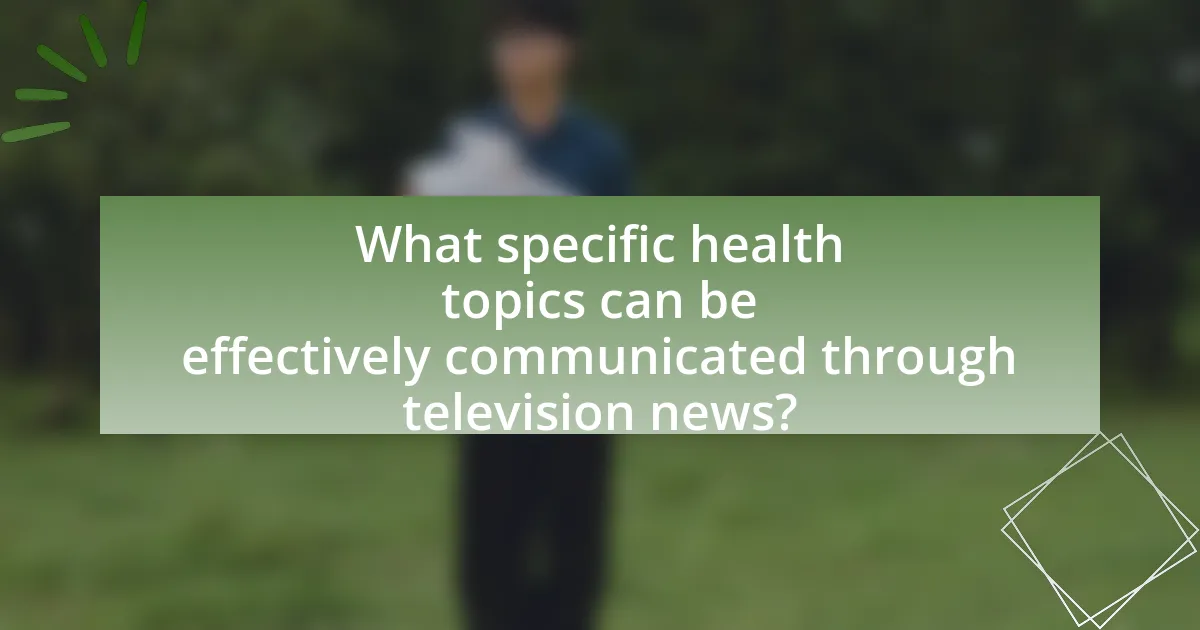
What specific health topics can be effectively communicated through television news?
Television news can effectively communicate specific health topics such as disease prevention, mental health awareness, nutrition, and public health emergencies. These topics are impactful because they address immediate concerns and provide actionable information to the public. For instance, during the COVID-19 pandemic, television news played a crucial role in disseminating information about safety protocols, vaccination updates, and health guidelines, which significantly influenced public behavior and compliance. Studies have shown that visual media, including television, enhances understanding and retention of health information, making it a powerful tool for public health messaging.
How can television news address emerging public health crises?
Television news can address emerging public health crises by providing timely, accurate information and expert analysis to the public. By prioritizing coverage of health issues, news outlets can inform viewers about the nature of the crisis, preventive measures, and available resources. For instance, during the COVID-19 pandemic, television news played a crucial role in disseminating information about symptoms, vaccination efforts, and public health guidelines, which helped to shape public behavior and awareness. Research indicates that effective communication through television can significantly influence public understanding and response to health emergencies, as seen in studies conducted by the World Health Organization, which emphasize the importance of media in health crisis management.
What strategies can be used to report on infectious disease outbreaks?
Effective strategies to report on infectious disease outbreaks include timely dissemination of accurate information, collaboration with public health authorities, and utilizing multiple media platforms. Timely dissemination ensures that the public receives updates as soon as possible, which is crucial during an outbreak to prevent misinformation and panic. Collaboration with public health authorities allows news outlets to provide credible information and guidance, enhancing the reliability of the reports. Utilizing multiple media platforms, such as television, social media, and online news, maximizes reach and ensures diverse audiences receive essential health messages. These strategies have been shown to improve public understanding and response during health crises, as evidenced by the rapid communication efforts during the COVID-19 pandemic, which highlighted the importance of clear and consistent messaging from trusted sources.
How can mental health issues be sensitively covered in news segments?
Mental health issues can be sensitively covered in news segments by employing accurate language, avoiding stigmatizing terms, and prioritizing the voices of individuals with lived experiences. Accurate language ensures that the portrayal of mental health is respectful and reflects the complexities of these conditions, as evidenced by guidelines from organizations like the National Alliance on Mental Illness, which recommend using person-first language. Additionally, including expert opinions and resources for support can provide context and encourage viewers to seek help, thereby fostering a more informed public discourse on mental health.
What role does community engagement play in health reporting?
Community engagement plays a crucial role in health reporting by ensuring that the information disseminated is relevant, accurate, and reflective of the community’s needs. Engaged communities provide valuable insights and feedback that help journalists understand local health issues, leading to more targeted and effective reporting. For instance, studies have shown that health stories that incorporate community voices and experiences are more likely to resonate with audiences, thereby increasing public awareness and understanding of health topics. This engagement fosters trust between health reporters and the community, which is essential for effective communication and public health initiatives.
How can local stories enhance the relevance of health news?
Local stories enhance the relevance of health news by providing context that resonates with the community’s specific health concerns and experiences. When health news is tied to local narratives, it becomes more relatable and actionable for the audience, leading to increased engagement and understanding. For instance, a study by the Pew Research Center found that local news coverage of health issues significantly influences public perception and behavior, as individuals are more likely to respond to health information that reflects their own community’s challenges and successes. This localized approach not only fosters a sense of urgency but also encourages community members to take proactive steps in addressing health issues, thereby improving overall public health awareness.
What methods can be used to involve viewers in health discussions?
To involve viewers in health discussions, television news can utilize interactive formats such as live polls, social media engagement, and expert Q&A sessions. These methods encourage audience participation and create a sense of community around health topics. For instance, live polls during broadcasts allow viewers to express their opinions in real-time, while social media platforms enable discussions and sharing of personal experiences related to health issues. Research indicates that interactive content increases viewer engagement by up to 70%, demonstrating the effectiveness of these methods in fostering active participation in health discussions.
How can television news utilize technology to improve health awareness?
Television news can utilize technology to improve health awareness by integrating real-time data analytics and interactive platforms. By employing data analytics, news outlets can present up-to-date health statistics, trends, and alerts, allowing viewers to understand the current health landscape effectively. For instance, during the COVID-19 pandemic, many news channels used interactive maps and dashboards to display infection rates and vaccination progress, which significantly enhanced public understanding and response to health measures. Additionally, interactive platforms such as social media and mobile applications enable viewers to engage with health content, ask questions, and receive personalized health information, thereby fostering a more informed public.
What are the benefits of using social media to complement health news broadcasts?
Using social media to complement health news broadcasts enhances audience engagement and information dissemination. Social media platforms allow for real-time interaction, enabling viewers to ask questions and share personal experiences related to health topics, which can lead to a deeper understanding of the issues presented in broadcasts. Additionally, studies show that health information shared on social media can reach a broader audience; for instance, a 2020 study published in the Journal of Medical Internet Research found that health-related posts on platforms like Twitter and Facebook significantly increased public awareness and knowledge about health issues. This synergy between social media and traditional broadcasts not only amplifies the reach of health messages but also fosters community discussions, ultimately contributing to improved public health awareness.
How can interactive features enhance viewer engagement with health topics?
Interactive features enhance viewer engagement with health topics by allowing audiences to actively participate in the content, leading to increased retention and understanding. For instance, features such as polls, quizzes, and live Q&A sessions enable viewers to express their opinions and ask questions, fostering a sense of community and involvement. Research indicates that interactive content can increase viewer engagement by up to 70%, as it transforms passive viewing into an active learning experience. This active participation not only makes the information more relatable but also encourages viewers to take action regarding their health, thereby improving public health awareness.

What are the outcomes of effective public health awareness through television news?
Effective public health awareness through television news leads to increased knowledge, behavior change, and improved health outcomes among the population. Research indicates that when health information is disseminated via television, viewers are more likely to adopt healthier behaviors, such as increased vaccination rates and improved dietary choices. For instance, a study published in the American Journal of Public Health found that public service announcements about flu vaccinations significantly increased vaccination rates by 20% in communities exposed to the campaigns. Additionally, television news can enhance public engagement in health initiatives, as seen during the COVID-19 pandemic, where consistent coverage led to heightened awareness and compliance with health guidelines.
How does increased health awareness impact community health outcomes?
Increased health awareness significantly improves community health outcomes by promoting preventive behaviors and encouraging healthier lifestyle choices. Research indicates that communities with higher health awareness experience lower rates of chronic diseases, as individuals are more likely to engage in regular health screenings and adopt healthier diets. For instance, a study published in the American Journal of Public Health found that increased health literacy is associated with a 20% reduction in hospital admissions due to preventable conditions. This correlation demonstrates that when individuals are informed about health risks and preventive measures, they are more likely to take proactive steps, leading to overall better health in the community.
What evidence exists linking health news coverage to behavioral changes?
Health news coverage is linked to behavioral changes through various studies demonstrating its impact on public health actions. For instance, a study published in the American Journal of Public Health found that increased coverage of health issues, such as smoking cessation, led to a significant rise in quit attempts among smokers. Additionally, research by the Pew Research Center indicated that individuals exposed to health news are more likely to adopt healthier behaviors, such as increased physical activity and improved dietary choices. These findings illustrate that health news coverage can effectively influence public behavior and promote healthier lifestyles.
How can television news contribute to health literacy among viewers?
Television news can enhance health literacy among viewers by providing accessible information about health issues, preventive measures, and medical advancements. By broadcasting segments that explain complex health topics in simple language, television news helps demystify medical jargon, making it easier for the general public to understand critical health information. For instance, studies have shown that health-related news segments can increase awareness of diseases and promote healthy behaviors; a report from the Pew Research Center indicated that 62% of Americans turn to television for health information, highlighting its role as a primary source of health education.
What are the best practices for viewers to critically engage with health news?
Viewers can critically engage with health news by evaluating the credibility of sources, analyzing the evidence presented, and considering the context of the information. Credible sources include peer-reviewed journals and reputable health organizations, which provide reliable data. Analyzing evidence involves checking for citations, understanding study designs, and recognizing potential biases in reporting. Additionally, considering the context means understanding the broader public health implications and how the news fits into existing health narratives. Research indicates that informed viewers are better equipped to discern misinformation, as highlighted in a study by the Pew Research Center, which found that individuals who actively seek out diverse sources of information are more likely to have accurate health knowledge.
How can viewers discern credible health information from sensationalized news?
Viewers can discern credible health information from sensationalized news by critically evaluating the source, checking for evidence-based data, and assessing the language used. Credible sources typically include peer-reviewed journals, reputable health organizations, and qualified experts, while sensationalized news often relies on emotional language and anecdotal evidence. For instance, a study published in the Journal of Health Communication found that information from established health organizations was more likely to be accurate compared to sensationalized reports, which often exaggerate risks or benefits. By prioritizing information from these reliable sources and being wary of overly dramatic headlines, viewers can make informed decisions about their health.
What steps can individuals take to stay informed about public health issues?
Individuals can stay informed about public health issues by regularly following reputable news sources, including television news programs that focus on health topics. These programs often provide updates on current health crises, research findings, and public health recommendations. For instance, the Centers for Disease Control and Prevention (CDC) and the World Health Organization (WHO) frequently collaborate with media outlets to disseminate accurate health information. Additionally, subscribing to health-related newsletters and utilizing social media platforms to follow public health organizations can enhance awareness. Engaging with community health initiatives and attending local health forums also contributes to staying informed.
